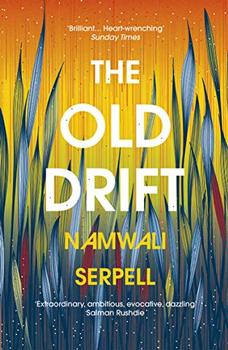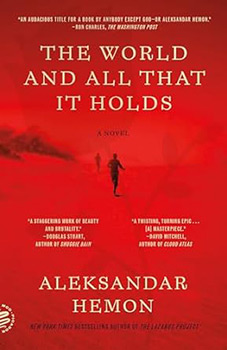Summary | Excerpt | Reading Guide | Reviews | Beyond the book | Read-Alikes | Genres & Themes | Author Bio

This panoramic (576 page) debut novel spans a tumultuous century of socio-political and family dynamics in Zambia. The first section, "The Grandmothers," unrolls like a meandering river and introduces native and colonial characters whose descendants will propel the next two sections, titled "The Mothers" and "The Children," respectively. I was most drawn to the third section, which churns like the rapids, then floods in a surge of future-set climate catastrophe. The novel depicts a pageant of complex characters from many racial backgrounds (with a family tree supplied for reference), unifying in a dramatic chorus that ties together the narrative with broader themes.
Author Namwali Serpell was born in Zambia to a black mother and white British father, then moved to the United States during her childhood. In many ways, The Old Drift reads like a love letter to her homeland. She describes the essence of its primordial landscape before European influence:
The night was luminous with moonlight. In the foreground was the bluff of Barouka island. Beyond it, veiled in spray, the main falls leapt roaring into the chasm four hundred feet below. The spray was so powerful it was hard to say whether the Falls flowed up or down. The shadowy black forest writhed its branches before them.
During the late 1800s, when the novel opens, the British South African Company colonizes and exploits the region spanning the mighty Zambezi River, and names it Rhodesia after white mining magnate Cecil Rhodes. Rhodesia's northern portion, Zambia, gained independence from colonial rule in 1964; and Southern Rhodesia, now Zimbabwe, in 1980, following decades of civil war. Tension between traditional ways and colonial imperatives, old languages and new are evident everywhere in this novel. Scottish missionary David Livingstone is the first European to see the great waterfall, known by locals as Mosi-oa-Tunya ("The Smoke that Thunders"); but Livingstone names it Victoria Falls, after his queen. Naming is one of the most obvious ways that colonists permanently mark the region.
True history braids with fiction throughout The Old Drift. For example, in the 1950s, a consortium of industrialists constructed the Kariba Dam across the Zambezi River. Meanwhile, two of Serpell's characters, Federico and Sibilla, flee their homeland (Italy) under mysterious circumstances. Federico works as an engineer on the dam project. Their child, Isabella, will eventually marry a prosperous Indian merchant, Balaji. Their daughter, Naila, born in Lusaka, is one of three main characters in the ultimate section of the novel.
Typical of racial crosscurrents, here's an excerpt of Naila's encounter with Joseph, after he has spotted her stealing from patrons at the university cafeteria.
'You were born here?'
'Born and bred, exay.'
'But your parents are what?'
'Guess.' She spoked her fingers up into her hair—long, purpleblack, shaved on one side.
'I give up,' he said then tried anyway: 'Ethiopian?'
'You're mixed too, ya? Green eyes and that.'
'We say coloured here, but yes. Are you sure you're from Lusaka?'
'What kind of mutt are you?' She blew smoke from the side of her mouth like Popeye.
'Muntu-musungu. I'm not exactly sure what proportion. You?'
'Musungu-mwenye. Exactly half,' she said. 'My mum's Italian.'
'So basically muzungu,' he said.
Joseph, the son of a "coloured" (a term used in Zambia to describe a mixed race person) father, Dr. Lee Banda and black mom, Thandi, grows up during the HIV epidemic. Dr. Lee actively researches a cure. Joseph advances his father's work, collaborating with outside investors to create and market a vaccine. Things do not go as planned, but when Joseph reconnects with early childhood friends Naila and Jacob, the plot unfurls in wild directions. The three young adults yearn to create positive change in a world ravaged by climate change, poverty, malaria and HIV. It's hinted that Jacob and Joseph may in fact be half-brothers, sired by the promiscuous Dr. Lee Banda. Jacob is also an innovator, scavenging junkyard parts to design and build drones.
Jacob's mother, Sylvia, runs the Fly-Away hair salon with her best friend, Loveness. They're both also sex workers, living and working in Kalingalinga, an eclectic neighborhood of the capital, Lusaka, with many small markets, shanty dwellings, shebeens (bars) and empty fields. In a further braid of fiction with fact, Sylvia's fictional mom, Matha, and father Godfrey, are based on real-life 1960s freedom-fighter activists who participated in Zambia's fringe "Afronaut" program for space exploration.
By 2023, when the novel reaches its climax, most of the population is connected through a communications grid. A "Digit-All Bead" is something like a smart phone, but condensed to a mini-implant on a finger. In Serpell's world, the Zambian government offers free "Beading" to anyone. Connectivity appears to be for the common good (enhancing communications and allowing social protest); but may in fact impose authoritarian control (tracking people and vaccinating them without consent). While the older people are skeptical; most youth are eager for Bead implants. Though entirely fictional, the notion of Beading does not seem at all far-fetched in our increasingly plugged-in real world.
This novel is not a one-night read, but an intricate exploration of major historical and current events. With a lens on Zambia, the book grapples with universal questions: Who "owns" the land or its minerals, or a river's power? Why do some live in mansions and others in shanty structures built from salvaged cardboard and soda pop bottles? How can people remain healthy when invisible menaces (malaria, HIV, dysentery) constantly assault? How can a territory of many cultures transcend historic conflicts and systematic oppression? Will the miniature but mighty mosquito conquer all? Can key innovations arise from visionaries in remote regions, far from the technologically advanced superpower nations with their prestigious universities? Beneath the human pageant that Serpell directs, nature pulses with its own imperatives; a gifted storyteller delivers an intriguing, sometimes challenging novel.
![]() This review was originally published in The BookBrowse Review in May 2019, and has been updated for the
April 2020 edition.
Click here to go to this issue.
This review was originally published in The BookBrowse Review in May 2019, and has been updated for the
April 2020 edition.
Click here to go to this issue.

If you liked The Old Drift, try these:

The Creation of Half-Broken People
by Siphiwe Gloria Ndlovu
Published 2025
Stupendous African Gothic, by the winner of Yale University's Windham–Campbell Prize.

The World and All That It Holds
by Aleksandar Hemon
Published 2024
The World and All That It Holds―in all its hilarious, heartbreaking, erotic, philosophical glory―showcases Aleksandar Hemon's celebrated talent at its pinnacle. It is a grand, tender, sweeping story that spans decades and continents. It cements Hemon as one of the boldest voices in fiction.
Your guide toexceptional books
BookBrowse seeks out and recommends the best in contemporary fiction and nonfiction—books that not only engage and entertain but also deepen our understanding of ourselves and the world around us.